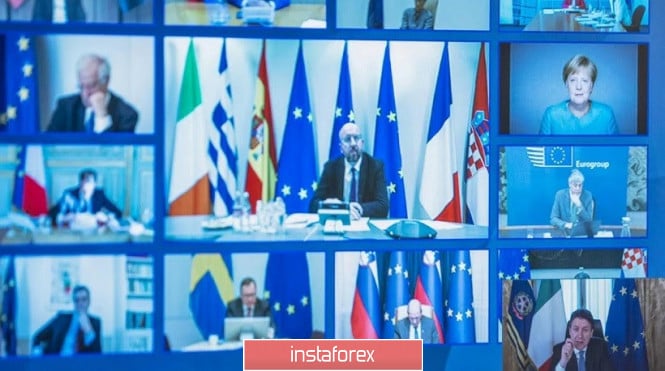Many of the world's trading platforms are closed today – the Catholic world is celebrating Good Friday. On the eve of a long weekend due to the Easter holidays, traders are cautious and do not risk opening large positions. Although the fundamental background for the EUR/USD pair contributes to increased volatility, given recent events. First, members of the Eurogroup were still able to agree on a package of financial assistance to the EU countries, and secondly, OPEC+ countries signed an agreement to reduce oil production (the demarche of Mexico may disrupt the deal, but negotiations with Mexico city are still ongoing). We should also not forget about the actions of the Federal Reserve, which launched a new credit program. On the one hand, there are all prerequisites for further growth of EUR/USD at the moment, but on the other hand, some fairly significant nuances do not allow the pair's bulls to show character.

But let's start with the latest decisions of the Eurogroup. At the end of the second round of negotiations, EU finance ministers still agreed on a package of stimulus measures for 540 billion euros. First, officials approved the provision of credit support for 240 billion euros. This money will be allocated to countries affected by the crisis from the European Stability Mechanism, but with one condition – the funds received must be spent on health care. The credit line will be open until the end of the crisis. Secondly, the Eurogroup members were able to agree on a temporary program to combat unemployment and crisis situations. It includes the allocation of about 100 billion euros, which will be used to provide loans to countries on preferential terms. These loans are also targeted in nature – the money should be used to provide financial assistance to those who have been left out of work during the epidemic.
Small and medium-sized businesses were also not left without credit support – 200 billion euros were allocated for this purpose. In addition, members of the Eurogroup announced their intention to create a special fund for the recovery of the eurozone economy in the post-crisis period. As the head of the Eurogroup Mario Centeno noted, after the EU countries begin to "very carefully remove restrictions", they will need assistance, and this will be provided by the above-mentioned special fund.
It is worth noting that traders of the EUR/USD pair reacted rather coolly to the long-awaited decision of the Eurogroup. The pair rose to 1.0950, but further growth was questionable – the price was stuck in the flat. In my opinion, this is due to several fundamental factors. First, the market is trading in a low liquidity environment. Today, in particular, the trading platforms of Germany, France, great Britain, Australia, New Zealand, Canada and many other countries are closed. The first day of next week will also be a weekend – Easter Monday. On the eve of such holidays, traders do not risk opening large positions, especially given the ongoing coronavirus epidemic.
Secondly, the agreement reached does not mention the use of shared debt to finance recovery, i.e. the notorious crown bonds. Representatives of the southern countries of Europe — Italy, France and Spain — strongly insisted on the introduction of crown bonds. But representatives of Northern Europe – Germany, the Netherlands, Finland, and Estonia - categorically opposed this idea. As we can see, as a result of this confrontation, the North prevailed over the South. And here it is necessary to take into account that at this stage the agreement was agreed only by the EU finance ministers – now this decision must be discussed and approved by the leaders of the 27 EU countries. This means that the parties have yet to conduct many more complex discussions on this issue.
Italian Prime Minister Giuseppe Conte made a rather harsh statement on the eve of the second round of negotiations - according to him, the European integration project will be "threatened" if the bloc countries do not agree on an economic response to the coronavirus pandemic. At the same time, he zealously defends the idea of introducing crown bonds - at the first online summit, he very emotionally discussed this with his colleagues, but, as we see, he could not convince them. Given this disposition, it can be assumed that the following online summit of EU leaders will not be a simple formality: representatives of the south will probably raise the issue of crown bonds again, which they have been insisting on for several consecutive weeks. Therefore, EUR/USD buyers are in no hurry to "uncork champagne", especially since the date of this meeting has not yet been determined (and it is possible that it can take place on weekends).
Thirdly, the EUR/USD bulls lost indirect support from the oil market - let me remind you that OPEC + members were able to agree that oil production will be reduced by 10 million barrels per day in May and June, by 8 million from July to December, and by 6 million since January 2021. But this agreement may remain "on paper", as the Mexicans opposed - they refused to reduce their oil production by 400 thousand barrels per day. At the moment, negotiations have reached an impasse, although key members of the cartel were able to find a common denominator in this matter.

Thus, the situation has largely remained in limbo. In general, there are all prerequisites for further growth, but the EUR/USD bulls lack only a few puzzles that would push the pair up to the 10th figure. From a technical point of view, if the pair consolidates above the resistance level of 1.0950 (Tenkan-sen line on the daily chart), then it will be possible to consider long positions to the level of 1.1010 (middle line of Bollinger Bands on the weekly chart).
The material has been provided by InstaForex Company - www.instaforex.com